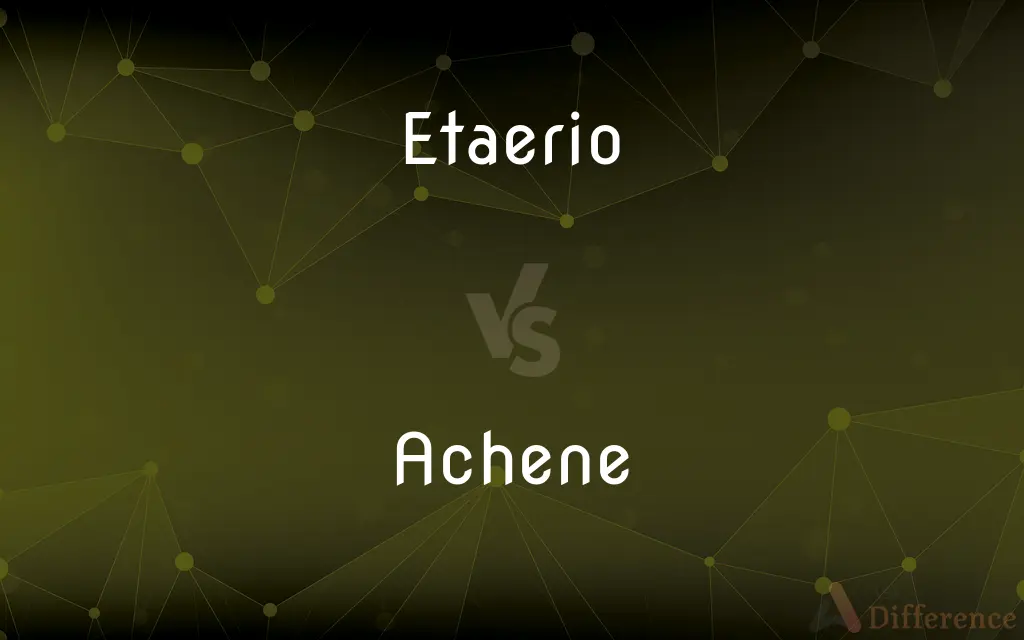Etaerio vs. Achene — What's the Difference?
By Tayyaba Rehman & Urooj Arif — Updated on May 10, 2024
"Etaerio" refers to a cluster of fruit derived from several ovaries of one flower, while "Achene" is a simple, dry fruit that doesn’t open at maturity and contains a single seed.

Difference Between Etaerio and Achene
Table of Contents
ADVERTISEMENT
Key Differences
An etaerio forms when multiple ovaries within a single flower develop into fruits, resulting in a cluster. Whereas an achene consists of a single ovary developing into a fruit, typically seen in sunflowers.
Etaerios can be found in plants like strawberries and raspberries, showcasing a collection of smaller fruits joined together. On the other hand, achenes are characteristic of many plants, including buttercups, where each fruit is a standalone entity.
Structurally, etaerios demonstrate the cooperative nature of multiple fruits originating from a singular floral structure. In contrast, each achene is an individualistic fruit that remains closed and contains only one seed.
The formation of an etaerio involves the fusion of several ovaries, which is not the case in achenes. Achenes, instead, are formed from a single ovary and typically have a hard outer coating protecting the seed.
In terms of dispersal, etaerios such as raspberries attract animals with their clustered, colorful appearance, aiding in the distribution of seeds. Achenes, however, often rely on wind or animal fur for dispersal, as seen with dandelion seeds.
ADVERTISEMENT
Comparison Chart
Definition
Cluster of fruits developed from several ovaries
Simple, dry fruit that doesn’t open, containing one seed
Example Plants
Strawberries, raspberries
Sunflowers, dandelions
Seed Containment
Multiple seeds across multiple fruits
Single seed within each fruit
Fruit Structure
Fruits fuse together from a single flower
Individual fruit with a hard coating
Dispersal Mechanism
Attracts animals due to clustered appearance
Wind dispersal or attachment to animals
Compare with Definitions
Etaerio
Develops from multiple ovaries.
Each ovary in a flower contributes to the etaerio’s structure.
Achene
Protective outer layer keeps the seed safe.
The tough exterior of an achene protects the seed from environmental factors.
Etaerio
Found commonly in aggregate fruits.
Etaerios are easily identifiable in a ripe strawberry.
Achene
Dispersed primarily by wind.
Dandelion achenes are carried away by the breeze.
Etaerio
A fruit type consisting of a cluster of fruits derived from one flower.
The raspberry is an etaerio formed by many tiny drupelets.
Achene
Contains a single seed.
Each achene has only one seed, making it a simple fruit.
Etaerio
Visually distinctive due to its composite nature.
The etaerio of blackberries makes them popular in fruit salads.
Achene
Common in various flowering plants.
Achenes are predominant in plants like dandelions.
Etaerio
Aids in effective seed dispersal.
The clustered nature of etaerios helps in attracting birds and animals.
Achene
A type of dry fruit that does not open upon maturity.
The achene of a sunflower is encased in a hard shell.
Etaerio
(botany) An aggregate fruit of achenes, drupes, or follicles.
Achene
An achene (; Greek ἀ, a, privative + χαίνειν, chainein, to gape; also sometimes called akene and occasionally achenium or achenocarp) is a type of simple dry fruit produced by many species of flowering plants. Achenes are monocarpellate (formed from one carpel) and indehiscent (they do not open at maturity).
Achene
A small, dry, indehiscent one-seeded fruit with a thin wall, as in a sunflower.
Achene
(botany) A small, dry, indehiscent fruit, containing a single seed, as in the buttercup.
Achene
A small, dry, indehiscent fruit, containing a single seed, as in the buttercup; - called a naked seed by the earlier botanists.
Achene
Small dry indehiscent fruit with the seed distinct from the fruit wall
Common Curiosities
What is an etaerio?
It’s a cluster of fruits that forms from the ovaries of one flower.
How is an achene different from other fruit types?
It’s a dry fruit that doesn’t open at maturity, containing a single seed.
What is the typical dispersal mechanism for achenes?
Achenes are usually dispersed by wind or by adhering to animals.
How does the structure of an etaerio affect its dispersal?
The clustered structure helps attract animals which aids in dispersal.
Are etaerios found in all flowering plants?
No, they are specific to certain plants that produce aggregate fruits.
Can you give examples of plants that produce etaerios?
Strawberries and raspberries are common examples.
Is an achene always hard?
Yes, achenes typically have a hard coating to protect the seed.
What biological purpose does the achene serve?
It protects the seed until conditions are right for germination.
How do etaerios contribute to a plant’s reproduction?
They attract animals for seed dispersal through their appearance.
What is an achene?
An achene is a type of dry fruit that contains a single seed and does not open at maturity. It is enclosed in a hard outer shell.
Share Your Discovery

Previous Comparison
Portal vs. Gate
Next Comparison
Scop vs. BardAuthor Spotlight
Written by
Tayyaba RehmanTayyaba Rehman is a distinguished writer, currently serving as a primary contributor to askdifference.com. As a researcher in semantics and etymology, Tayyaba's passion for the complexity of languages and their distinctions has found a perfect home on the platform. Tayyaba delves into the intricacies of language, distinguishing between commonly confused words and phrases, thereby providing clarity for readers worldwide.
Co-written by
Urooj ArifUrooj is a skilled content writer at Ask Difference, known for her exceptional ability to simplify complex topics into engaging and informative content. With a passion for research and a flair for clear, concise writing, she consistently delivers articles that resonate with our diverse audience.
















































